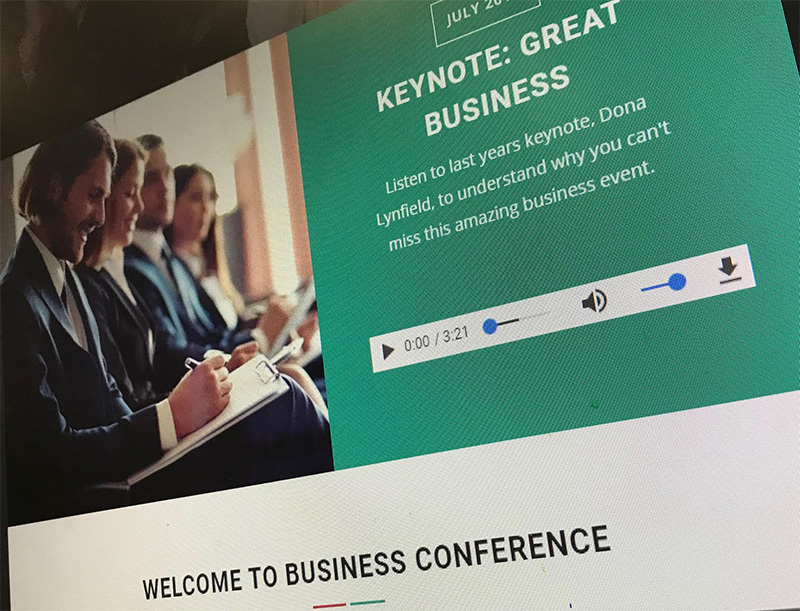Tony Robbins is a powerful speaker who has a real ability to motivate his audience and use his charisma to promote and build a personal brand. What I find fascinating is how he chooses to communicate. Not just the words and language, but the tools he uses to further empower his message and how it gets received.
Even incredible speakers need to find the appropriate platform for their message.
During an episode of #AskGaryVee with Gary Vaynerchuk, Tony Robbins described how he uses audio email to ensure his message arrives with maximum impact, context and emotion. Being able to passionately communicate one-to-one is powerful, but how does Tony do that with email?
Tony Robbins: “I use audio emails much more than regular emails because you can hear a voice, you’ve got context you can’t get that in normal emails. If it’s a couple of lines I’ll type it but if it’s something that has emotion to it, I want people to hear it so they can connect with it.”
Tony is able to carry his passion for a topic through an email by using his own voice to deliver that message to an audience. It creates an incredibly human interaction using technology that can sometimes feel impersonal.
How else can we use audio with email marketing?
It’s no surprise audio content infiltrated our daily lives with the rise of apps like Spotify, iTunes and Google Play, making not only music easier to access, but also podcasts, audiobooks and audio-based content.
Even on video platforms like YouTube, audio content is HUGE and constantly gets featured in the trending section.
So you want to email audio content, you’ve got two options. Either attach the file to your email (which works well for one-to-one emails). Or use a service like Vision6 to embed an audio player in your email directly or send an email that links to where your audio is stored. Using a service like Vision6, you can distribute your content to a wider audience as well as track clicks and engagement.
Start experimenting with calls to action in your emails to track their click-through rates in comparison to your other content (such as blogs, videos, updates, etc). Using your reports, you can use your click map to see what parts of your email are getting the most attention.
If you’re feeling brave, you can try embedding an audio player directly into your email. Multiple inboxes support the use of the <audio> tag within the HTML of your email and it’s easy to add this in Vision6. Keep in mind audio is widely supported in Apple Mail and on iOS devices, but things get murky outside Apple’s safe-space for audio.
|
Share your podcasts, keynotes and audio messages directly in your email. With incredible support on mobile phones, you can actually use Media Queries to single out mobile phone users and deliver embedded audio to those devices.
Our code above uses a royalty-free audio track from Incomptech (so be sure to attach your own audio files here). It’s also worth noting you’ll need to host your own file or link to an audio file directly.
As always, test your emails. Test different devices and inboxes, make sure your audio email is being delivered properly and that it’s working within your own marketing strategy.

Aren’t emails with attachments more likely to get SPAM’ed?
When sending from your personal email account to one other recipient, your email always has a better chance of being delivered. I don’t recommend attaching files to email campaigns you’re sending to lists. You may want to consider embedding the audio content into the HTML or linking to a page that contains an audio player.
For one-to-one emails, attaching a file can be incredibly effective but we also need to consider the size of the attached file.
Certain sizes will be blocked from being delivered. I’d recommend trying to keep any voice recording to less than 10 minutes long.
You also need to consider that inboxes can fill up fast, so be mindful of how large your audio files are before sending. Using the Voice Memo App it’s incredibly easy to trim any excess off the start and end of your recording (as well as any pauses).
How to record and email an audio clip using Voice Memo
When producing content, I’ll often use the voice memo app on my iPhone to record voice snippets I can then email to myself. It’s an incredibly efficient way to record, edit and distribute audio content all from a mobile phone. Once the clip is in my inbox, I can drop it into an email and send it off, download to my computer or send it to Google Drive for archiving.
![]()
See Apple’s step-by-step guide to everything Voice Memo can do.
So what’s the take away here for Audio Email?
Email has proven itself consistently as a great way to get your message into the hands of your recipient. But finding an opportunity to do something out of the ordinary and delight your audience can really give you the edge in the inbox. Not to mention help your messages carry more weight and context. Try it out and don’t forget, you can add emoji’s like a play button to your subject lines to let your recipients know it’s an email with playable ▷ content!


